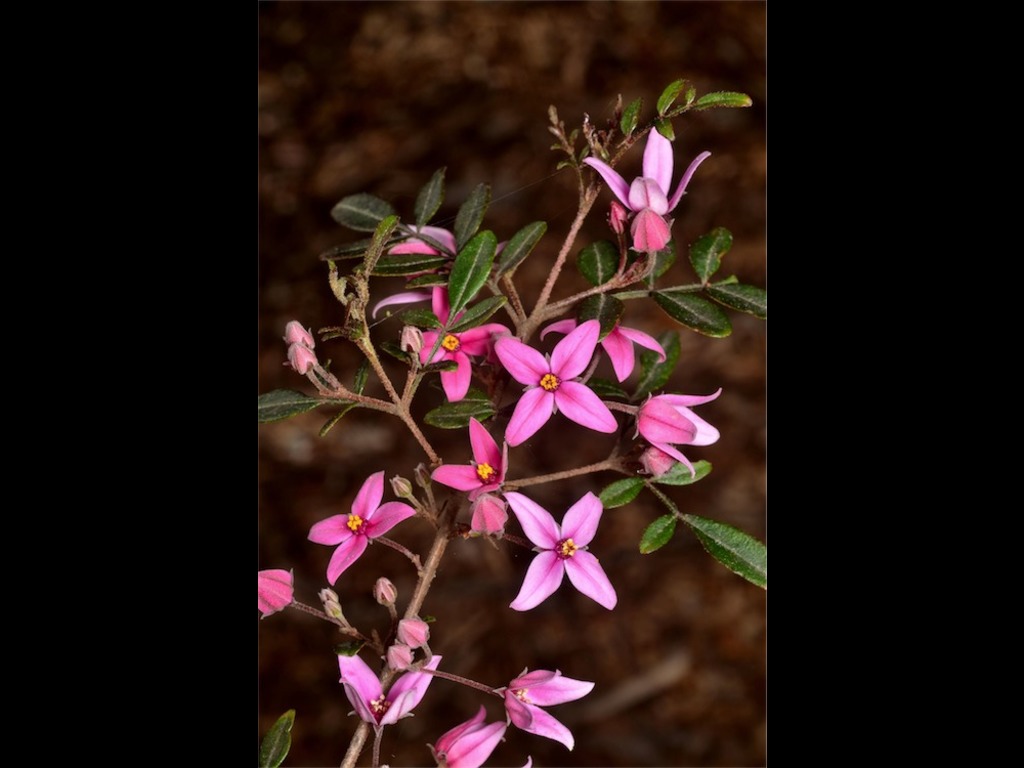Boronia 'Telopea Valley Star'
- File Number
- 181
- ACRA Field Book Number
- -
- Registration Date
- 23/07/1980
- Application Received
- 15/08/1979
- Family
- Rutaceae
- Cultivar Name
- Boronia 'Telopea Valley Star'
- Origin
- Boronia 'Telopea Valley Star' is said to be a hybrid between B. mollis and B. fraseri which was selected from a batch of seedlings grown from seed collected from cultivated plants. It was raised by Telopea Valley Nursery near Kulnura, NSW. Cultivar received by the Authority 15 August 1979.
- Characteristics
- Note: Formerly B. 'Telopea Star' This cultivar grows to plus/minus 1m tall by plus/minus 60cm wide. It is fast growing, has an erect habit, and has quite long distances (6-8cm) between nodes. These long internodal distances can tend to make the shrub look sparse. The cultivar has round stems, and the newer growth has a covering of fine brown hairs. The leaves are pinnate and glabrous, with the leaflets being from plus/minus 2.5cm long by plus/minus .7cm wide. The terminal leaflet is longer, being from plus/minus 3.5cm long by plus/minus 1cm wide. The leaflets are oblong-elliptical to lanceolate in shape. The flowers are borne in umbels of 3-6 flowers either terminally on the branchlets or in the leaf axils. They are pink in colour and star-shaped and open well to plus/minus 1.5cm in diameter. Flowers are profuse in the spring but odd flowers are found during most of the year. Diagnosis: This cultivar has only a light covering of brownish hairs on the newer growth and the leaves are glabrous. B. mollis has a denser covering of hairs on the new growth which extends for some distance down the stems. The leaves on B. mollis have stellate hairs on the under side of the leaves. The leaves of the cultivar when checked against specimens of B. mollis are generally much larger. Whereas B. fraseri has many trifoliate leaves, the leaves of the cultivar are truly pinnate. B. 'Telopea Valley Star' has the long internodes of B. mollis. B. fraseri has much more compact internodal distances, while B. fraseri has square sectioned stems. The cultivar is more robust than either of its purported parents. Comparators: Boronia mollis NBG 006544, 002848; B. fraseri NBG 065889, 065890.
- Cultivation
- The cultivar has been checked by the NSW National Herbarium and the ACRA. It has proved hardy in a number of situations in the 5 to 6 years it has been in cultivation. It has proved itself both in the Sydney and Canberra areas. In Canberra it has a tendency to grow sparse if not kept compact by pruning, which it accepts very readily. It grows well from cuttings, which method must be used to keep this cultivar form.
- Publication
- Australian Cultivar Registration Authority (1982), Australian Plant Cultivars. Australian Plants 11(90): 263
- Colour Coding
- RHS Colour Chart 1966. Flowers:petal: red purple group 61D, darkening towards the centre to 61C, central vein in petal:red purple group 61A, gynoecium: red purple group 59A.
- Propagation
- Cuttings from semi-firm new growth
- Applicant Name
- J R W and M B Grieve, C/- Post Office, Kulnura, NSW, 2250.
- Uses
- As part of a mass planting or mixed in a shrubbery, or as a spectacular feature plant. Cut flowers.
- Availability
- Kuranga Nursery
- ANBG Accession Numbers
- ACC181, CANB 654012
- NSL ID
- -

